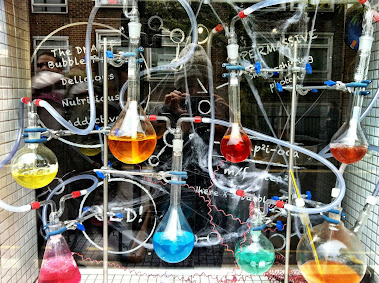Applications of the Gas Chromatography
Applications of Gas
chromatograph
Applications
of gas chromatography are as following:
1.Qualitative analysis:
By comparing the retention time or volume of
the sample to sample to the standard/ by collecting the individual components
as they emerge from the chromatography and identifying these compounds by other
methods like UV, IR, NMR.
2.Quantitative analysis:
Area
under a single component elution peak is proportional to the quantity of the
detected component / response factor of
the detectors.
a.
Direct
comparison method:
A(sample)
/ A(std) =αC(sample) /C(Std)
Where,α is the response factor determined for every pure compound
under given conditions.
b.
Calibration curve:
A graph is
plotted by taking peak areas on y-axis
and concentration of standard compounds on x-axis. Concentration of the unknown
sample is then determined by putting the value of its peak area on same graph.
C.
Internal
standard method:
A known concentration
of internal standard, which has similar retention characteristics that of
sample is added to both reference standard and test sample.
3.
Pharmaceutical:
Quality
control and the analysis of the drug products like antibiotics (penicillin),
antivirals (amantadine), general anesthetics (chloroform, ether), sedatives /
hypnotics a
Assay of
drugs-purity of compound can be determine for drugs like;
· Atropine sulphate
· Clone oil
· Stearic acid
· In determining the levels of
metabolitics in body fluids like plasma, serum, urine etc.
4.
Food and beverages applications:
· Food and beverages contain numerous
aromatic compounds, some naturally present in the raw material and some forming
during processing.
· GC is extensively used for the
analysis of these compounds which include esters, fatty acids, alcohols,
aldehydes, terpenes etc.
· Analysis of food is concerned with
the assay of lipids, proteins, carbohydrates, preservatives, flavours,
colorants, vitamins, steroids, drugs, and pesticides residues.
· Most of the components are
non-volatile (thus the use of HPLC) but with modification, GC can be
effectively used.
· It is also used to detect and measure
contaminants from spoilage or adulteration which may be harmful and which is
often controlled by governmental agencies For example; pesticides.
5.
Chemical analysis:
The GC
analysis of xylene isomers, there the xylene isomers are precursors to many
chemicals;
· o-xylene is a precursor for phthalic
anhydride
· m-xylene is a precursor for
isophthalic acid
· p-xylene is a precursor for
terephthalic acid and dimethyl terephthalate.
Thecresol
(methyl phenol) isomers are also precursors to many chemicals. This the
chromatogram of a mix of aromatic and methyl phenol compounds was generated
using on SLB-IL60 ionic liquid column. Its interaction mechanisms allow the
separation of all three xylene isomers, and all three cresol isomers.
Thank You




Comments
Post a Comment